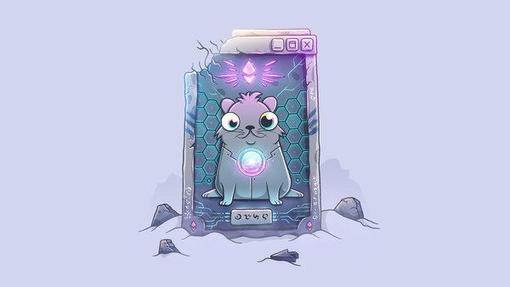A CryptoKitty digital artwork incorporated into a sculpture that recently sold for $140,000 at a charity auction in New York.CreditCryptoKitties
How does one invest in art without going through the complications of buying and owning an actual artwork?
That is the question behind financial products for investors attracted by soaring art prices but intimidated by the complexity and opacity of the market. It is why art funds were all the rage in the early 2000s, and why new variations continue to emerge.
At the same time, entrepreneurs are trying to iron out the archaic inefficiencies of the art world with new types of financial products, particularly the secure ledgers of blockchain. While the technology is best known as the basis of cryptocurrencies like Bitcoin, its promise of transparency could transform sectors like banking and insurance and, some say, art.
“More transparency equals more trust, more trust equals more transactions, more transactions equals stronger markets,” Anne Bracegirdle, a specialist in the photographs department at Christie’s, said on Tuesday at the auction house’s first Art & Tech Summit, dedicated to exploring blockchain.
According to Ms. Bracegirdle, blockchain’s decentralized record-keeping could create a “more welcoming art ecosystem” in which collectors and professionals routinely verify the authenticity, provenance and ownership of artworks on an industrywide registry securely situated in the cloud.
Hers was one of the more utopian visions put forward by the roughly 30 panelists at Christie’s daylong conference, however. There was plenty of skepticism on offer.
Sébastien Genco, a blockchain specialist at the auditing and financial services company Deloitte, said the percentage of global investment in this technology that related to art represented “almost nothing.”
Mr. Genco, in his talk at the Christie’s event, titled “Why the Art World Wasn’t Ready for Blockchain,” cited the art world’s slow embrace of technology, limited collaboration, lack of trust in a process that is not fully understood, and costs as some of the reasons blockchain had yet to have a significant impact on the art trade. But that could change, he said. “We just need to educate people.”
As the Christie’s event progressed, a clearer picture emerged of what blockchain could and could not (yet) do for the art world. The technology’s potential for verifying provenance, authenticity and ownership was widely cited by speakers and attendees.
“I see the benefit for my clients in terms of reliability of information,” said Harco van den Oever, chief executive of Overstone, a London-based company providing specialist services to banks that issue art-secured loans. “Blockchain is a secure database. I can’t rely on a piece of paper.”
And blockchain has already proved to be a game-changer in one important area of growth, according to those at the Christie’s event: art in digital forms.
“Digital art is a computer file that can be reproduced and redistributed infinitely. Where’s the resale value?” John Zettler, president of Rare Art Labs, a company building a platform for cryptocurrency art sales, said at the event. Blockchain’s proof-of-ownership technology, combined with blockchain-based cryptocurrencies such as Ethereum, have resulted in the “invention of scarcity” and a stronger market for digital art, he said.
Peter Brant, a seasoned collector who is part of the management team for a new art investment fund, with his wife, Stephanie SeymourCreditMax Lakner/BFA, via Shutterstock
Sales that attest to the viability of this market include the equivalent of $14,000 for one of the 10,000 characters created by the New York-based CryptoPunks, with proof of ownership stored on the Ethereum blockchain. There are also CryptoKitties, tradable virtual felines that have attracted more than 250,000 registered users and more than $25 million in transactions.
For other art and technology experts, “tokenization” — using the value of an artwork to underpin tradable digital tokens — is the way forward. “Blockchain represents a huge opportunity for the size of the market,” said Niccolò Filippo Veneri Savoia, founder of Look Lateral, a start-up looking to generate cryptocurrency trading in fractions of artworks.
“I see more transactions,” added Mr. Savoia, who pointed out that tokens representing a percentage of an artwork could be sold several times a year. “The crypto world will bring huge liquidity.”
But the challenge for tokenization ventures such as Look Lateral is finding works of art of sufficient quality to hold their value after being exposed to fractional trading. The art market puts a premium on “blue chip” works that have not been overtraded, and these tend to be bought by wealthy individuals, not by fintech start-ups.
With so much attention focused on such technological endeavors, the emergence of a new fund might seem like a blast from the art finance past. But that’s what we have in the recently and very discreetly introduced UTA Brant Fine Art Fund, devised by the seasoned New York collector Peter Brant and the United Talent Agency in Los Angeles.
The fund aims to invest $250 million in “best-in-class” postwar and contemporary works, according to the prospectus, using the expertise of a management team that consists of Mr. Brant; Jim Berkus, a co-founder of the talent agency, who is also a collector; and Joshua Roth, who leads the agency’s fine arts division. It has a target hold period of five to seven years, the prospectus says, and the minimum investment is $1 million.
Image
The United Talent Agency, which has started an art fund, also recently opened an art space in Los Angeles.CreditUnited Talent Agency
Noah Horowitz, in his 2011 primer, “Art of the Deal: Contemporary Art in a Global Financial Market,” listed 36 funds that had been introduced since 2000, of which at least 20 had folded by the end of 2009. High-profile failures, such as Fernwood Art Investments in the United States and the Osian Art Fund in India, rattled confidence in the model of fixed-term art investing, and few newcomers have been entering the sector.
Sourced through Scoop.it from: www.nytimes.com



Leave A Comment